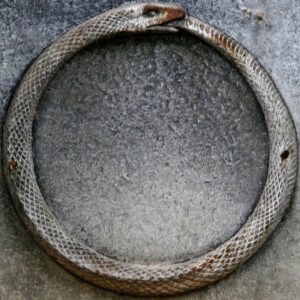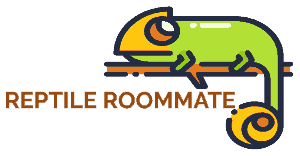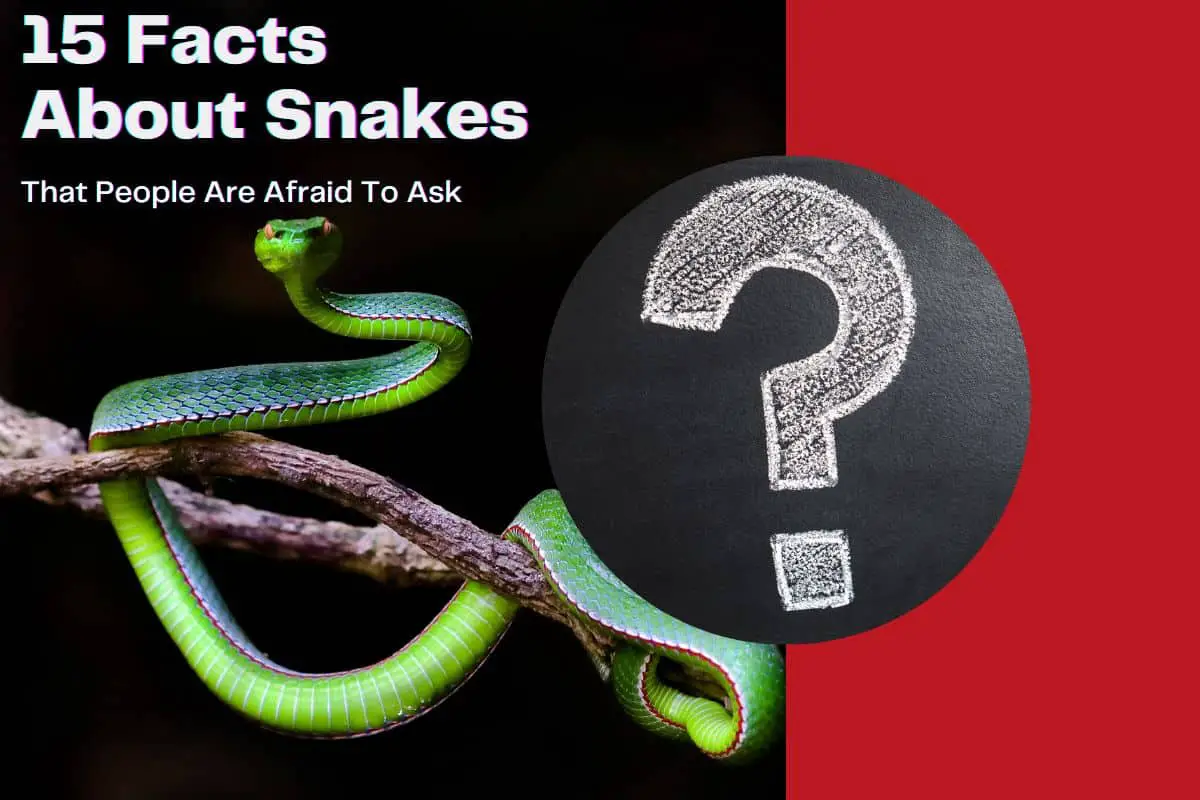15 Snake Facts That Will Blow Your Mind!
Are you thinking about getting a pet snake or are you looking for information about snakes but a couple of your questions are a little strange or make you feel embarrassed to ask them?
Not to worry!
Look no further than these 15 snake facts that will blow your mind! It doesn’t matter if the question is too weird, too simple, or too gross; they’ll all be answered here!
Reptile Roommate is a participant in the Amazon Services LLC Associates Program. As an Amazon Associate I earn from qualifying purchases.
#1 Why Would a Snake Bite Itself?

“Ouroboros (Uroborus)” by Leo Reynolds is licensed under CC BY-NC-SA 2.0
There are reports from around the world, as well as documented cases on videos, that show snakes biting themselves or even attempting to consume itself by swallowing its own tail!
One such instance occurred in the United Kingdom where a kingsnake was taken to the veterinarian after swallowing its own tail. The snake wasn’t able to “release” itself or remove the tail because a snake’s teeth are designed to hold onto prey and not allow it to reverse direction. (1)
Another popular video on social media shows an albino western hognose in its water bowl attempting to swallow itself!
There are also many instances of snakes that bite themselves both on social media and forums on the internet. If you keep snakes or know someone that does you may have even witnessed this for yourself!
Even a decapitated snake’s head can bite!
Sometimes people have been “bitten” after killing a snake and on some occasions snakes will bite their wriggling body with the decapitated head!
A decapitated snake head only “bites” because of muscle contractions and postmortem spasms, not because it consciously bit itself.
However, snakes that bite themselves while alive may do so for a number of reasons.
Many cases of a snake biting itself are simply mistakes; confusion about what is food or what isn’t or an attempted strike that misses the target and inadvertently connects with the snake’s own body.
It is also believed that when snakes are overheated, stressed or confronted with unusual circumstances they can become even more reliant on their “primitive reptile brain” impulses and this may cause them confusion or even aggression that would lead to biting their own tail or body.
Snakes can and sometimes do bite themselves, whether it be from the overheating of this cold blooded reptile, to poor husbandry and stress or even by simple mistake; not only do snakes bite their prey but they can bite themselves too!
#2 What Do Baby Snakes Eat?
We all know that snakes swallow their prey whole by stretching out and opening their mouths really wide and slowing “crawling” the meal back into their stomachs.
You may have seen snakes, or own a snake, that eats a variety of rodents (mice and rats) and in the case of larger snakes even rabbits! However, what do baby snakes eat? Can a baby snake eat a rodent? Are baby snakes fed by their mother?
To answer this question as simply as possible, baby snakes, being very small, eat very small prey! Okay, that may be the simple answer but what kinds of small things do they eat?
Newborn snakes in the wild eat a variety of prey animals that they can catch and swallow like insects, frogs and amphibians, baby mice and basically any small animals that fit in their mouths!
Snakes in the wild have to be opportunistic feeders, eating whatever they can find, capture and in the case with small baby snakes, fit in their mouth. In captivity however, we as keepers provide food that is appropriately sized for them.
Most popularly kept pet snakes are fed rodent diets; mice and rats.
Some snakes are larger or smaller when they are born depending on the species. A larger species of snake, like a boa constrictor, may be able to handle a larger meal than a smaller species can.
Baby snakes that are kept in the reptile hobby are usually fed baby mice or baby rats called pinkies. As the mice or rats get larger in size (from pinkies to fuzzies to hoppers and so on) they can be fed to larger sized snakes.
#3 Do Snakes Die with Their Eyes Open?
Snakes do EVERYTHING with their eyes open, including dying! Why is that you may ask..?
Snakes have no eyelids! They have no choice! Incredibly snakes have a clear protective scale covering each eye that prevents debris from entering the eye as well as keeping it moist.
This scale can be easily observed during a snake’s shed cycle during the blue stage, as you’ll notice the eye become opaque and turn a shade of blue-gray. This scale is pulled away during the shedding process and a new clear protective scale remains!
Having no eyelids means that snakes can’t blink (wink!) or close their eyes which can make it difficult to tell a sleeping snake from a snake at rest from even a DEAD snake!
Snakes both LIVE and DIE with their eyes WIDE OPEN!
#4 How Long Do Snakes Move After Death?
Cold-blooded animals like snakes don’t generate their own body heat like warm-blooded animals do, this means that a snake’s oxygen requirements are lower than say a human or a dog.
Having lower oxygen requirements means that a snake’s brain can survive conditions without the availability of oxygen for much longer than warm-blooded animals can.
This is the reason that snakes and other reptiles can continue to move after death; even with the ability to bite!
This reflex retention can last minutes to hours after death!
Since this movement can be present for such a long time after death, caution must be taken when dealing with or handling a deceased snake.
Venomous snakes that are deceased MUST be handled with extreme caution because of this phenomenon.
People can, and have been, envenomated by snakes that were already dead!
#5 Are Snakes Cold Blooded?
Snakes, like alligators, turtles, lizards and chameleons are all reptiles. Reptiles are cold-blooded; (2)
these ectothermic animals rely on the environment to regulate and maintain their body temperature.
The term “coldblooded” is actually a misnomer, it doesn’t actually mean that a snake’s blood is “cold,” it only refers to the fact that a snake relies on the environment to maintain temperature since it doesn’t generate its own heat.
Warm-blooded animals (mainly mammals and birds) maintain constant body temperature through metabolic means regardless of environmental temperatures.
Unlike humans (and other mammals) snakes always need to move around searching for warmer or cooler spaces in their environment to regulate their temperature. This is the reason that heat (and light) is such an important part of reptile keeping!
#6 What Are Baby Snakes Called?
Baby snakes actually have a few different names depending on their age and the way that they were born.
Snakes that hatch from eggs are referred to as hatchlings and snakes that are born live (little replicas of their parents) are called neonates!
Hatchlings vs Noenates
Snakes are commonly thought of as an egg-laying animal and while almost seventy percent of all snakes in the world lay eggs, not all of them do.
Those snakes that lay eggs are what is called oviparous,
an egg producing animal that hatch their offspring outside of their bodies. (3)
The eggs can be fertilized inside or outside of the body but the eggs are laid and tended to while the young develop inside until they are ready to hatch and become hatchlings.
This is in contrast to viviparous snakes which give birth to live young. These snakes develop inside the mother’s body within a placenta that nourishes them until they are birthed by the mother. (4)
Boa constrictors are a popular example of viviparous snakes that give birth to live young or neonates.
A third way that some snakes are born are from species that are ovoviviparous, sort of a combination of egg laying and live birth.
Ovoviviparous snake embryos do develop inside an egg, but unlike eggs that are laid and develop in the outside environment and then hatch, these snakes develop in “soft eggs” inside the mother’s body and then are birthed as live offspring! (5)
What Do We Call Baby Snakes AFTER They Are Born?
Both hatchlings and neonates are terms that refer to snakes after birth, however as they grow hatchlings AND neonates become snakelets!
A snakelet is the term used to describe a young or “baby” snake!
#7 Can Snakes Climb Walls?
Snakes aren’t able to climb the walls of your bedroom or smooth surfaces the way that geckos can.
Geckos have microscopic hairs on their toe pads called setae that enables them to “stick” to smooth surfaces and climb walls! Snakes lack such features.
That said, snakes can easily climb rough surfaces such as brick or stone walls and they are very adept at climbing trees, branches and bushes!
#8 Do Snakes Blink?
Not only do snakes NOT blink but they couldn’t even do it if they wanted to!
Snakes lack eyelids so they’re unable to wink at a cute snake slithering by or even blink at all!
Instead snakes have a specially developed clear scale that covers each eye and gives its protection and helps retain moisture.
#9 How Often Do Snakes Poop?
So you had to go there huh? Well, snake waste, or poop, is actually a big part of keeping a pet snake just like it is a dog or cat. However, snakes have a “poop advantage” over their furry pet siblings!
First things first, the “waste” that comes out of a snake isn’t just poop (excrement).
Snake excrement is a combination of brown or black semi-formed feces, a white chalky substance known as urates, and occasionally some mucous, urine and indigestible parts of their meal like bones, teeth, claws and fur.
Diet, temperature and feeding frequency all have an effect on snake digestion. Snakes usually poop after each meal, but depending on the size of the snake and the size of the meal that could take days, weeks or in some cases months after eating!
How often a particular snake will poop comes down to how much it is eating or how often you feed it. Also, different species of snakes will generally poop more often than others. A (very general) “rule” would be the larger the snake, the longer in between poops.
Some snakes’ frequency and look of their waste will differ from others. For example, garter snake poop tends to be less solid (runnier) than a ball python and garter snakes may poop every 2-3 days whereas a ball python may only go once or twice a month.
Again, these are all averages and even within the same species of snake you’ll find different schedules and consistencies of poop.
Well, I’m glad that’s over, I think I’m going to go wash my hands!
#10 Why Do Snakes Flick Their Tongues?
A snake flicking its forked tongue is one of the signature characteristics we all think of when talking about snakes.
Snakes use their tongues to “taste’ the air and gather information about their surroundings, to locate prey and to learn of any potential threats that may be nearby.
Scientists have even determined that snakes may flick their tongues not only to “taste” the air but to also taste objects on the ground. (6)
The signals that snakes receive by flicking their tongues are transferred to the snakes vomeronasal organ or Jacobson’s organ where this sensory information is sent to the brain to be processed.
#11 How Do Snakes Drink Water?
Snakes have the ability to siphon water by using suction, much like drinking from a straw. Snakes utilize rhythmic movement of muscles in their mouth and head to draw water into their mouths and swallow.
Snakes also have what many refer to as a “sponge” (or spongy) mouth. The folds of skin in a snake’s mouth are covered with soft tissue that can soak up water by capillary action; once these spongy tissues are full, muscles in the snake’s mouth can squeeze the “sponge” releasing the trapped water which is then swallowed.
It’s absolutely amazing the adaptations these animals had to make for the lack of lips to help them drink or large tongues (like a dog’s) for lapping up water.
Below is a quick informational video that explains these two processes which snakes use to drink water.
#12 Do Snakes Fart?
The good news for those that don’t have a dog to blame for passing gas is that maybe you can blame your pet snake!
Snakes fart!
It may be somewhat surprising but snakes do indeed pass gas. It’s not just a bad smell either, you might be surprised to find out that they can be pretty loud too!
Check out the video here (or don’t, you can just trust me) to listen to an actual snake fart!
#13 Do Snakes Have Ears?
Snakes don’t have visible external ears but they do have inner ear structures that are directly attached to their jawbone which allows them to feel the vibrations in their skulls.
However scientists were unsure if snakes could actually hear airborne sounds.
So a team of researchers, led by Christian Bech Christensen, conducted experiments that came to the conclusion that snakes could in fact hear low frequency airborne sounds. (7)
#14 Do Snakes Sleep?
Many may think that because snakes never close their eyes, they don’t or aren’t able to sleep.
Even though snakes lack eyelids preventing them from closing their eyes, they still find a way to sleep.
Snakes go through similar REM (rapid eye movement) stages of sleep just like we do; they just sleep with one (actually two) eyes open!
#15 Are Snakes Blind?
It is a common misconception that snakes are either blind or that they “go blind” during various times of the year.
Snakes can see although their sight may be somewhat poor and their sense of smell (and heat detection in some species) may be more relied upon, snakes can see.
As far as the myth that snakes “go blind” during summer or at particular times of year can be traced back to a snake’s shedding process.
The shedding process occurs through distinct stages and during the stage commonly referred to as “blue,” a snake’s normally clear eye scale (cap) will become opaque or a blueish color which eerily resembles the eyes of a blind person or someone with severe cataracts.
This discoloration of the snake’s eye cap does indeed impair its vision but this impairment is only temporary.
As a normal part of the shedding process, the opaque eye cap will soon be removed with the rest of the snake’s shed skin and underneath it will be replaced with a clear scale which the snake can see through.
Conclusion: 15 Snake Facts That Are No Longer Scary
There are NO questions that are too weird, too scary or too “dumb.” Never! In fact look for more of these questions to be answered here in the future!


